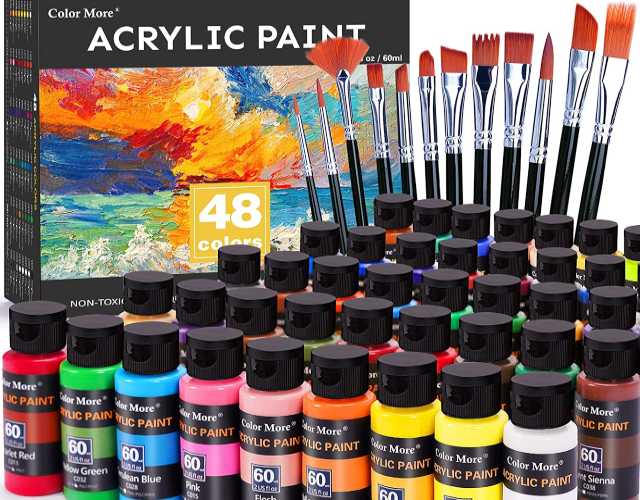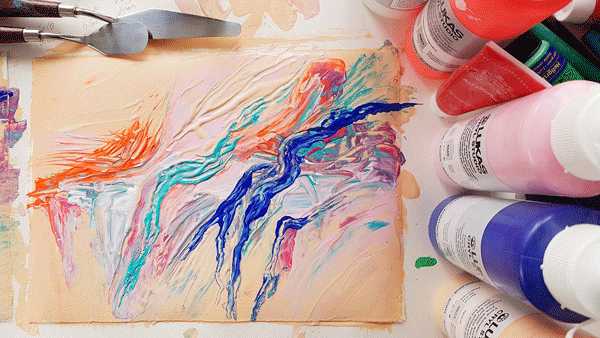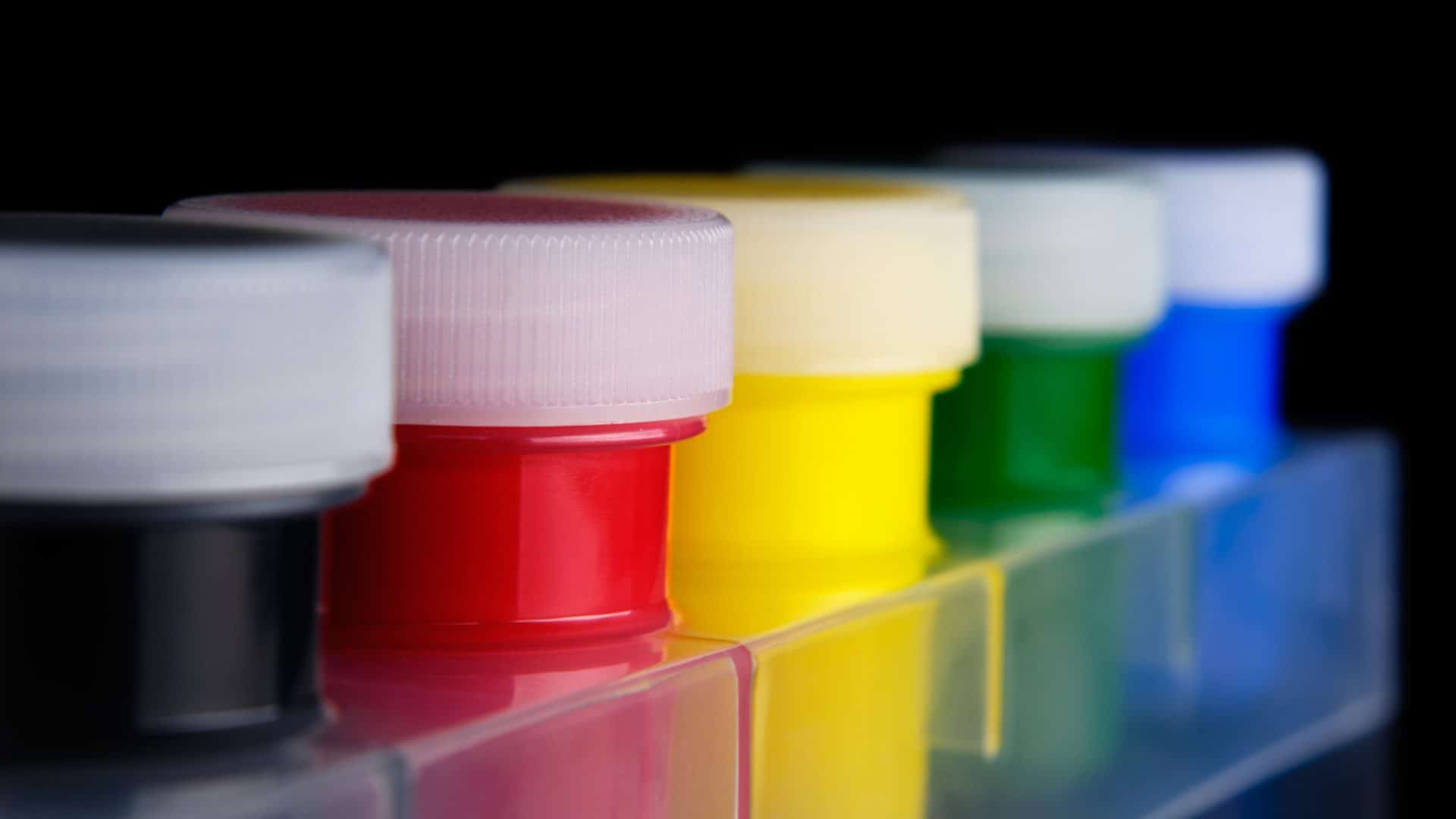As an artist, you’ve probably painted on several canvases but would now like to extend that creativity into your clothing, namely your T-shirts. By adding a medium to acrylic paints, you can transform some of your old T-shirts into works of art, giving them new life!
The differences between fabric paints and acrylic lie in:
- Composition of the paints
- Fabric types it can be used on
- Heat press requirements
- Overall look and touch of the fabric
- Wash and care of the garment after painting
- Variety of colors available with each paint
- And, the purpose of use
If you require information on the differences between acrylic paints and fabric paints and how to use them, this article will prove to be helpful.
Fabric Paint Versus Acrylic Paint
Fabric paints have been specially formulated for fabrics. They contain dye pigments combined with a solution that allows the pigments to bond to the fabric. Without this binding agent, the paint will not soak into the fabric to give you the colors or the finish you require.
However, fabric paint is best used on natural fabrics. This is because natural fabrics are more absorbent than synthetics. They can absorb the dye pigments better than synthetics.
Acrylic paints are a different stroke altogether. Although acrylic paints are water-based like fabric paints, they contain pigments suspended in an acrylic polymer emulsion. Unlike fabric paints though acrylic paints dry much quicker.
Acrylic paints are ideal for heavier fabrics such as canvas or denim because they are fast drying and water-resistant. Acrylic paints are also available in a far wider color spectrum than fabric paints.
How Does Fabric Paint Differ From Acrylic Paint?
To an inexperienced person, fabric paints may not differ from acrylic paints. You require a keen eye to spot the differences between these two art mediums. Some differences between fabric and acrylic paints are listed below to help you on your next creative project.
Fabric Paint Vs. Acrylic: Difference In Fabric Type

Fabric is confined only to natural fabrics, whereas acrylic paints may be used on both natural and synthetic fabrics. This allows for greater scope for artists to work with.
Fabric Paint Vs. Acrylic: Differences In Composition

Fabric paint contains dye pigments combined with an agent that binds the pigment molecules together, and it is this binding agent that enables fabric paint to adhere to the fabric. The fabric paints soak deep into the fibers of the fabric. On the other hand, acrylic paints adhere just to the surface of the fabric.
Fabric Paint Vs. Acrylic: Finished Appearance
Acrylic paints dry to create a thick, hard layer over the surface of the fabric. In comparison, fabric paints seep and blend into the fabric, not altering the structure or texture of the fabric.
Fabric Paint Vs. Acrylic: Comfort And Drape

Fabric paints, specially formulated for use on fabrics, can be used on all types of garments, bed linens, and accessories, including some shoes. The painted items or garments retain the shape drape and can be folded even after painting, free from any difficulties.
Garments painted on with acrylic paints become stiff and virtually impossible to drape or fold. You may use acrylic paints on a pair of jeans or a T-shirt, but avoid using them on curtains, bed linens, or any item that requires them to be draped or folded.
The thick hardened layer of acrylic paint on the fabric surface also makes painted bed linen very uncomfortable! Cracks are formed when the sheet or pillowcase is folded, which can be unsightly.
Not to mention the strong paint aroma is unhealthy.
Fabric Paints Vs. Acrylic: Drying Method
Fabric paints require a heat source, such as a heat press, blow dryer, or iron, for the paint to set into the fabric completely. If the paint is not set into the fabric in this way, it may bleed during a wash cycle, thereby damaging the garment.
However, this is not the case with acrylic paints. Being acrylic, the paint sets immediately upon application to the fabric surface.
Fabric Paint Vs. Acrylic: Wash Process
Fabric paint is hardy enough to withstand many washes. The colors on the design may fade with use, but the design does not chip or crackle.
On the other hand, designs painted on using acrylic paint tend to crackle and peel after much use. Therefore, acrylic paints are unsuitable for wearable garments and are best for decorative items that do not require washing or ironing.
Fabric Paint Vs. Acrylic: Fabric Medium

Garments or accessories which have designs painted with fabric paints can be machine washed or hand washed under normal washing conditions. Although the colors may fade over time, the fabric and the design will remain the same.
A medium mixer is required to render the fabric washable with acrylic paints. The paint will crackle when the painted fabric is dropped into the washing machine due to the high temperatures. A medium mixer is added to the detergent to prevent damage to the paint.
Fabric Paint Vs. Acrylic: Correcting A Mishap
Fabric paint is water-soluble, so in the event of any mistakes, while painting, they can easily be corrected. You may only correct mistakes before the design is set by applying a heat source.
With acrylic paints, it hardens almost instantaneously and becomes permanent. It becomes challenging to correct if you make a mistake while painting.
Fabric Paint Versus Acrylic Paint: Difference In Purpose Of Use

The differences between fabric paint and acrylic paints also lie in the purpose of use, that is, will they be applied to garments worn daily or used on items for a decorative purpose?
The following points may help with this decision.
- Fabric paints are best suited for natural fabrics such as cotton, wool, silk, linen, etc. The dyes and pigments are easily absorbed deep into the fabric fibers and not just on the fabric’s surface. Fabric paints may be used on every clothing type, from hats, T-shirts, shoes to bed linen.
- Once applied to the garment or clothing, the fabric paint does not change the item’s look, feel, or texture. The garment or clothing items remain comfortable and soft through many washes and daily use.
- Conversely, although acrylic paints are available in brighter colors that add a burst of color that outdated clothing may need, the garments may not be comfortable to wear as the paint becomes stiff and prone to crackle.
- Acrylic paints may be used on any type of fabric, natural or synthetic. However, they are unsuitable for garments worn daily. Therefore acrylic paints are best used on decorative items such as tablecloths, placemats, handbags, or cushion covers.
These items are not used daily, so washing is unnecessary. So, therefore, the colors and design are retained.
Techniques For Using Acrylic Paints On Fabrics
You can change your dull and dreary duvet cover into a stunning work of art by painting a bright sunflower over it! There are endless techniques for using acrylics on fabrics. Let your creativity and imagination flow by using the following hints and techniques.
1. Always wash, dry, and press your fabric or garment before painting. Certain fabrics may shrink or stretch after wash which may not be pleasant for your final product.
2. Use a plastic tablecloth over your work surface to ensure your finished artwork does not adhere to the surface. It is also good to place a barrier such as stiff cardboard between multiple layers of fabric to prevent the painting from bleeding through the fabric to the other side.
3. Sponging or using stamps are two ways of applying acrylic paints onto fabrics, especially if it is over a large surface area such as a duvet cover, tablecloth, or curtain.
4. For use over non-washable items, there is no need to use a medium with acrylic paint. The paint may be applied using a palette knife or brush.
5. Just as you build layers with oil paints, you can do the same with acrylics on fabrics. However, I suggest using a heavier fabric such as denim or canvas because acrylic paints are unsuitable for wearable products.

6. Sometimes, you may need to sand the fabric’s surface with fine sandpaper. By scratching over the surface, you give the paint a rougher surface to cling to.
7. If you wear the painted garment, a fabric medium should be added to the acrylic paint. This fabric medium keeps the fabric soft and comfortable for wear. The medium allows you to paint fabric to create a watercolor or airbrush look easily.
8. Finally and most importantly, acrylic paints are fast-drying, so it is best to work on smaller sections at a time to avoid the paint setting too fast!
Conclusion
There are many differences between fabric and acrylic paints. They are discernible only to the trained eye. Acrylic paints are best suited for creative or decorative projects around the home, whereas fabric paints may cheer up garments that have not aged well. Let your imagination and creativity flow with whichever paint you prefer to work with.
Bryan E. Robinson is the former owner of TshirtGrowth. He has sold t-shirts since 2006 through dropshipping, screen printing, vinyl printing, DTG, Print on Demand, and more. Bryan has created his own t-shirt designs through Photoshop, Canva, and other platforms, as well as worked with freelancers to create many of his designs. Besides t-shirts, Bryan has over 18 years of experience in online marketing with eCommerce, B2B SaaS, B2C products, and more.


